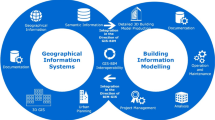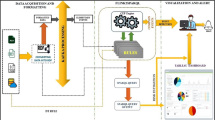Abstract
A hierarchical granular model that includes a variation of the Extended Gustafson–Kessel (EGK) clustering algorithm for massive event data sets applied in hotspot analysis is proposed. We construct a granular view of the distribution of hotspots on a geographic map related to a phenomenon, whose data are collected in a massive data set. To obtain the final information granules, we partition randomly the data set in s chunks and execute the EGK clustering algorithm separately to each chunk in a distributed architecture. Finally, a weighted EGK clustering algorithm is applied to a data set formed by the centers of all the local hotspots to the elliptical hotspots which constitute the upper level information granules giving a global overview of the spatial distribution of the hotspots on the map. Two indices are calculated to assess how justifiable is this granular view in terms of spatial distribution of the final hotspots on the map. A set of tests on the massive data set Archive Fire from Indonesia are performed by setting a threshold for the above two indexes and by varying the number of chunks. The results show that the proposed algorithm provides a justifiable granular view of the hotspot detected on the map. Comparison tests with respect to other clustering hotspot detection algorithms show that the proposed method is very efficient in terms of execution time and spatial distribution of the final hotspots.






Similar content being viewed by others
References
Anderson TK (2009) Kernel density estimation and K-means clustering to profile road accident hotspots. Accid Anal Prev 41(3):359–364
Bezdek JC, Ehrlich R, Full W (1984) FCM: the fuzzy c-means clustering algorithm. Comput Geosci 10(2–3):191–203
Birant SD, Kult A (2007) ST-DBSCAN: an algorithm for clustering spatial-temporal data. Data Knowl Eng 60(1):208–221
Campello RJ, Moulavi D, Sander J (2013) Density-based clustering based on hierarchical density estimates. In: Pacific-Asia conference on knowledge discovery and data mining. Springer, Berlin, pp 160–172
Chainey S, Ratcliffe J (2013) GIS and crime mapping: identifying crime hotspots. Wiley, Hoboken
Di Martino F, Sessa S (2011) The extended fuzzy C-means algorithm for hotspots in spatio-temporal GIS. Expert Syst Appl 38(9):11829–11836
Di Martino F, Sessa S (2013) Hotspots detection in spatial analysis via the extended Gustafson–Kessel algorithm. Adv Fuzzy Syst 2013:876073
Di Martino F, Sessa S (2018) Extended Fuzzy C-Means hotspot detection for large and very large event datasets. Inf Sci 44:198–215
Di Martino F, Sessa S, Barillari UES, Barillari MR (2014) Spatio-temporal hotspots and application on a disease analysis case via GIS. Soft Comput 18(12):2377–2384
Di Martino F, Sessa S, Mele R, Barillari UES, Barillari MR (2016) WebGIS based on spatio-temporal hotspots: an application to oto-laryngo-pharyngeal diseases. Soft Comput 20:2134–2247
Eschrich S, Goldgof D, Hall L, Ke J (2003) Fast accurate fuzzy clustering through data reduction. IEEE Trans Fuzzy Syst 11(2):262–269
Grubesic TH, Mack EA (2008) Spatial-temporal interaction of urban crime. J Quant Criminol 24(3):285–306
Grubesic TH, Murray AT (2001) Detecting hotspots using cluster analysis and GIS. In: Fifth annual int. crime mapping research conf., Dallas
Gustafson DE, Kessel WC (1979) Fuzzy clustering with a fuzzy covariance matrix. In: Proceedings of the 17th IEEE conf. decision control, San Diego, pp 761–766
Havens TC, Bezdek JC, Leckie CR, Hall LO, Palaniswami M (2012) Fuzzy C-means algorithms for very large data. IEEE Trans Fuzzy Syst 20(6):1130–1146
Hore P, Goldgof D, Hall L (2007) Single pass fuzzy C-means. In: Proceedings IEEE international conf. fuzzy systems, London, pp 1–7
Hore P, Goldgof D, Gu Y, Hall L, Maudsley A (2009) A scalable framework for segmenting magnetic resonance images. J Signal Process Syst 54:183–203
Kaur R, Sehra SS (2014) Analyzing and displaying of crime hotspots using fuzzy mapping method. Int J Comput Appl 103(1):25–28
Kaymak U, Setnes M (2002) Fuzzy clustering with volume prototype and adaptive cluster merging. IEEE Trans Fuzzy Syst 10(6):705–712
Lawson AB (2010) Hotspot detection and clustering: ways and means. Environ Ecol Stat 17(2):231–245
Levine N (2017) CrimeStat: a spatial statistical program for the analysis of crime incidents. In: Shekhar S, Xiong H, Zhou X (eds) Encyclopedia of GIS. Springer, Cham. https://doi.org/10.1007/978-3-319-17885-1_229
Lingras P, Haider F, Triff M (2016) Granular meta-clustering based on hierarchical, network, and temporal connections. Granul Comput 1:71–92
Nisa KK, Andrianto HA, Mardhiyyah R (2014) Hotspot clustering using DBSCAN algorithm and shiny web framework. In: Proceedings of international conference on advance computer sci. and information systems, Jakarta, pp 129–132
Pedrycz W (2013) Granular computing: analysis and design of intelligent systems. CRC, Boca Raton
Pedrycz W, Chen SM (2011) Granular computing and intelligent systems: design with information granules of higher order. Springer, Heidelberg
Pedrycz W, Chen SM (2015a) Granular computing and decision-making: interactive and iterative approaches. Springer, Heidelberg
Pedrycz W, Chen SM (2015b) Information granularity, big data, and computational intelligence. Springer, Heidelberg
Pedrycz W, Homenda W (2013) Building the fundamentals of granular computing: a principle of justifiable granularity. Appl Soft Comput 13:4209–4218
Pedrycz W, Al-Hmouz R, Balamash AA, Morfeq A (2015) Hierarchical granular clustering: an emergence of information granules of higher type and higher order. IEEE Trans Fuzzy Syst 23(6):2270–2283
Peters G, Weber R (2016) DCC: a framework for dynamic granular clustering. Granul Comput 1:1–11
Stopka TJ, Goulart MA, Meyers DJ et al (2017) Identifying and characterizing hepatitis C virus hotspots in Massachusetts: a spatial epidemiological approach. BMC Infect Dis 17(1):294
Usman M, Sitanggang IS, Syaufina L (2015) Hotspot distribution analyses based on peat characteristics using density-based spatial clustering. Procedia Environ Sci 24:132–140
Vadrevu KP, Csiszar I, Ellicott E, Giglio L, Badarinath KVS, Vermote E, Justice C (2013) Hotspot analysis of vegetation fires and intensity in the Indian region. IEEE J Select Top Appl Earth Obs Remote Sens 6(1):224–228
Acknowledgements
This research was performed under the auspices of GCNS-INDAM. We thank anonymous reviewers for detailed comments which improved greatly the contents of this work.
Author information
Authors and Affiliations
Corresponding author
Additional information
Publisher’s Note
Springer Nature remains neutral with regard to jurisdictional claims in published maps and institutional affiliations.
Rights and permissions
About this article
Cite this article
Di Martino, F., Sessa, S. Extended Gustafson–Kessel granular hotspot detection. Granul. Comput. 5, 85–95 (2020). https://doi.org/10.1007/s41066-018-0128-z
Received:
Accepted:
Published:
Issue Date:
DOI: https://doi.org/10.1007/s41066-018-0128-z




